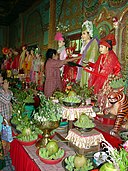Manimekhala

Manimekhala (Template:Lang-pi) is a goddess in the Hindu-Buddhist mythology. She is regarded as a guardian of the seas, namely the Indian Ocean and the South China Sea as part of the mythology of Southeast Asia. She was placed by Cātummahārājika to protect virtuous beings from shipwreck.[1] She appears in several Buddhist stories including the Mahanipata Jataka (Mahajanaka Jataka), in which she rescues Prince Mahajanaka from a shipwreck.[2]
Etymology
In Pali, maṇīmekhalā refers to a girdle or belt of jewels. In Southeast Asia, she is known by various indigenized appellations, including as Mani Maykhala (Template:Lang-my) in Burmese, as Moni Mekhala (Template:Lang-km) or Neang Mekhala (Template:Lang-km) in Khmer; as Mani Mekkhala (Template:Lang-th) in Thai.
In Mainland Southeast Asia
Archaeological evidence of Manimekhala in the form of reliefs has been found in Zothoke, Myanmar (near Bilin, dating to the first millennium AD.[3]
Manimekhala is seen in wat paintings across Mainland Southeast Asia depicting scenes from the Mahajanaka.[2] In Thailand and Cambodia, she is considered a goddess of lightning and the seas.
Manimekhala and Ramasura
The story of Manimekhala and Ramasura (in Cambodia known as Moni Mekhala and Ream Eyso) is mentioned many times in the classical literature of Cambodia and Thailand. It depicts Manimekhala along with Ramasura (usually considered a depiction of Parashurama) and Arjuna. According to legend, the phenomena of lightning and thunder is produced from the flashing of Manimekhala's crystal ball and the sound of Ramasura's axe as he pursues her through the skies.[4][5]
In Sri Lanka
In Sri Lanka, she is considered to be the sea goddess. In the Tamil epic poem, the Manimekalai, she puts the eponymous heroine to sleep and takes her to the island Maṇipallavam (Nainatheevu). In the mythic cycle of the god Devol, when the latter approaches Sri Lanka and his ship founders, it is Manimekhalai, on the instructions of the god Śakra, who conjures up a stone boat to save him.
Dance
In the classical dance traditions of Thailand and Cambodia, sacred dramatic dances depict the story of Manimekhala and Ramasura.
Cambodia
Robam Moni Mekhala (Template:Lang-km, also known as Robam Mekhala-Reamesor) is a Khmer classical dance that portrays the story of Moni Mekhala and Reamesor. It is part of the buong suong dance suite that is among the most sacred of Khmer classical dances, serving a ceremonial purpose to invoke rain upon the land.[6]
Thailand
In Thailand, the Mekkhala–Ramasun dance was performed as a boek rong ('prelude dance') introduction before main performances of lakhon nai or khon dances.[7][8]
In modern usage
- The popular Burmese pop singer Maykhala derives her stage name from Manimekhala.
- Her name was contributed by Thailand for tropical cyclone names occurring as 'Tropical Storm Mekkhala' in 2002 and 2008.
See also
- Arjuna
- Manimekalai
- Nyai Roro Kidul, a sea goddess in the legends of nearby Indonesia
References
- ^ G.P. Malalasekera. Dictionary of Pali Proper Names: Pali-English. Asian Educational Services, 2003
- ^ a b Anne Elizabeth Monius. Imagining a place for Buddhism: literary culture and religious community in Tamil-speaking South India. Oxford University Press US, 2001, pages 111-112
- ^ MOORE, ELIZABETH; WIN, SAN (2007). "The Gold Coast: Suvannabhumi? Lower Myanmar Walled Sites of the First Millennium A.D.". Asian Perspectives. 46 (1): 202–232. ISSN 0066-8435. JSTOR 42928710.
- ^ Candelario, Rosemary (2014-04-14). "Moni Mekhala and Ream Eyso Edited by Prumsodun Ok (review)". Asian Theatre Journal. 31 (1): 324–326. doi:10.1353/atj.2014.0027. ISSN 1527-2109.
- ^ "Cambodian Folktales | Southeast Asia Program". seap.einaudi.cornell.edu. Retrieved 2019-11-22.
- ^ Cravath, Paul. Asian Theatre Journal, Vol. 3, No. 2 (Autumn, 1986), pp. 179-203 (The Ritual Origins of the Classical Dance Drama of Cambodia) University of Hawai'i Press
- ^ "เรียนรู้เรื่องรำไทย ระบำชุด เมขลารามสูร". natasinsamphan.com (in Thai). Retrieved 15 March 2020.
- ^ Prasert Sontipong (2002). กระบวนท่ารำของรามสูรในการแสดงเบิกโรงละครใน [Ramasura dance patterns in lakon nai dance prelude] (master's thesis). Chulalongkorn University. ISBN 974-17-2465-9.

